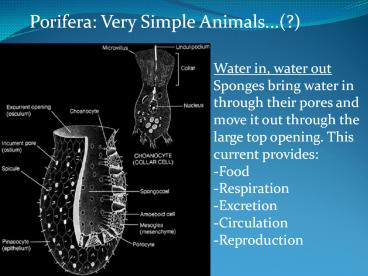Porifera: The Sponges - PowerPoint PPT Presentation
1 / 11
Title:
Porifera: The Sponges
Description:
Porifera: Very Simple Animals...(?) Water in, water out Sponges bring water in through their pores and move it out through the large top opening. – PowerPoint PPT presentation
Number of Views:124
Avg rating:3.0/5.0
Title: Porifera: The Sponges
1
Porifera Very Simple Animals...(?)
Water in, water out Sponges bring water in
through their pores and move it out through the
large top opening. This current
provides -Food -Respiration -Excretion -Circulati
on -Reproduction
2
(No Transcript)
3
-No nervous system -Many produce toxins -Create
many symbiotic relationships (mutualism and
commensalism) Sexual Reproduction -Sponges form
both eggs and sperm -The sperm move on current to
other sponges Asexual Reproduction -A bud
comes off the sponge and grows -Produce
gemmules in times of stress
4
Cnidarians
-Jellies -Hydra -Anemones -Corals
5
- Cnidarians
- Soft-bodied carnivores
- Have tentacles with specialized cells called
nematocysts that shoot poisonous darts into prey
(p. 669) - Radial symmetry with a central mouth surrounded
by tentacles - -Have two stages in their life-cycle a polyp and
a medusa. (p.670)
6
-Cnidarians paralyze prey with poison, then pull
it to their mouths and into the gastrovascular
cavity where it is digested. http//www.youtube.co
m/watch?vo1A5acWEERAfeaturerelated -They have
a nerve net of specialized cells that allow them
to detect touch, light and gravity. -Use a
hydrostatic skeleton to contract muscles for
movement. http//www.youtube.com/watch?v760lUxyle
6I
7
-Sexual reproduction occurs through external
fertilization where the zygote is a free-swimming
larva -The larva attaches to a surface and forms
a polyp. -The polyp can reproduce asexually by
budding young medusae.
8
The Jellyfish Scyphozoa (the cup
animals) -Range from tiny to almost 4 meters
across -Some species are extremely venomous- The
box jellyfish is the most venomous animal in the
world and has killed over 5 500 people since the
1950s.
9
Hydra and their Relatives -Hydras belong to the
class Hydrozoa -Most hydrozoans are colonies of
polyps performing specialized functions
(Portuguese Man O War) -Hydra are freshwater
hydrozoans that dont have a medusa stage. They
only live as polyps.
10
Anemones and Corals -This is the class Anthozoa
(flower animal) -Corals and anemones only have
the polyp stage -Anemones are solitary
polyps -Corals form colonies of polyps that look
like tiny anemones. -Colonies grow over thousands
of years producing calcium carbonate structures
that build huge reefs that are threatened. -Corals
form mutualistic relationships with
algae. -Anthozoans release clouds of sperm and
eggs into the water where the zygote becomes a
swimming larva before turning into a polyp.
11
(No Transcript)































